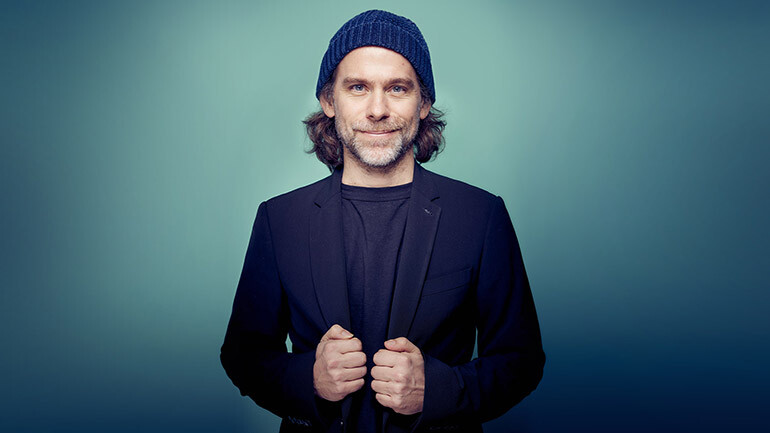Creative Expression as Rehabilitation: A Conversation with ’Sing Sing’ Composer Bryce Dessner

Bryce Dessner is a vital and rare force in new music. He has won GRAMMY Awards as a classical composer and with the band The National, of which he is founding member, guitarist, arranger and co-principal songwriter. Dessner is also accomplished film composer, having scored celebrated titles like Alejandro González Iñárritu’s The Revenant, for which he was GRAMMY and Golden Globe nominated, and Fernando Meirelles’s The Two Popes, Mike Mills’ C’mon C’mon, and Rebecca Miller’s She Came to Me, for which he crafted two opera pieces performed in the film, among others. Dessner has also written for prestigious ensembles like Orchestre de Paris and the Los Angeles Philharmonic.
Dessner’s most recent project, however, was truly unlike any film he’d been involved with. Sing Sing, directed by Greg Kwedar, is a striking drama based on the real-life Rehabilitation Through the Arts program at Sing Sing Maximum Security Prison. It was up to Dessner to create a musical world that would support and mirror the film’s remarkable cast, which includes actors Colman Domingo and Paul Raci as well as formerly Rehabilitation Through the Arts alumni like Clarence “Divine Eye,” Maclin and Jon-Adrian “JJ” Velaquez.
BMI spoke with Bryce Dessner about this unique project, the challenges he faced and the important message of the film. Here’s what he had to say.
This film tells a truly unique and inspiring story of how art is an incredibly powerful tool for positive self-actualization, community, and redemption, and Colman Domingo’s tour-de-force performance is superb. How did you first get involved?
This is the third film I have worked on with Greg Kwedar and his writing partner Clint Bentley (previously we had worked on Transpecos and Jockey). They sent me an early assembly of the first twenty minutes of the film, and I was so moved by it. Despite it being a very busy time for me, I immediately had to get involved with such an incredible project.
As you previously worked with director Greg Kwedar, can give us some insight into your collaboration process?
Greg and Clint are very clear collaborators. It has been a wonderfully creative partnership for me, and they give me an enormous amount of creative freedom. I think because the films are very strong and they have a high level of confidence in my work, I often am able to score exactly how I dream of working and they are very encouraging to go further with the work, as opposed to sometimes the negative feedback cycle that can occur when working on a project. They put a lot of trust in their collaborators, and it results in everyone wanting to give their absolute best to the project.
Tell us about your creative approach for the score given the backdrop of Sing Sing, the storyline, and the stunning performances of the ensemble cast?
In the initial work I did for the film, I was very inspired by this incredible ensemble cast and the story of these men and their experience in the Rehabilitation Through the Arts program at Sing Sing. There is a scene in the film that records with the characters looking out of the window towards the wilderness that surrounds the prison. The horizon line and the nature beyond those cement walls and barbwire become a kind of metaphor for the inner freedom that the characters are searching for in their work through creative expressions in the theater. I think this space beyond the walls is where the music exists, or perhaps it’s in interior space where the light comes in. I felt the music strongly could exist in that world, as opposed to composing to the anxiety or tension of the place itself. There is one moment in which the music comes into the prison when an important character dies, and the music in that moment is highly dissonant and fraught.
The film navigates different tones beautifully – friendship, love, regret, hardships – music sets the tone. Tell us about your recording process and your work with the London Contemporary Orchestra.
This was a very small budget film, and it was definitely not a given that we could afford to work with an orchestra. As I began writing, I was responding to the feeling of the ensemble and these individual characters and their relationships and growth together. This felt orchestral to me right away and I began writing for strings, winds, and brass and for soloists (cello, clarinet, sax, horn). I felt the picture and the story were asking for this approach, and so we started working that way. The film was funded in a very interesting way where every person involved above and below the line were paid the same day rate and everyone has equity in the film. This innovative and equitable model in the end allowed us to hire an orchestra. I have worked often in the past with Rob Ames and the London Contemporary Orchestra, who are really one of the best groups in the world and each member is like a soloist. I feel for this film it really merited working with an orchestra of this caliber.
Did seeing the formerly incarcerated men who’d participated in the Rehabilitation Through the Arts program at Sing Sing impact you creatively?
Honestly, from the very beginning this film was so beautiful and it’s meaningful to be involved with a project where the actors were mostly playing themselves and were telling their own story. It was very humbling and moving and a great, great honor to write music to accompany their work.
Sing Sing is in theaters now and Bryce Dessner’s score album in available for streaming and download on all major music platforms.








Community
Connect with BMI & Professional Songwriters